CAT Exam > CAT Questions > 1600 satellites were sent up by a country for...
Start Learning for Free
1600 satellites were sent up by a country for several purposes. The purposes are classified as broadcasting (B), communication (C), surveillance (S), and others (O). A satellite can serve multiple purposes; however a satellite serving either B, or C, or S does not serve O. The following facts are known about the satellites:
1. The numbers of satellites serving B, C, and S (though may be not exclusively) are in the ratio 2:1:1.
2. The number of satellites serving all three of B, C, and S is 100.
3. The number of satellites exclusively serving C is the same as the number of satellites exclusively serving S. This number is 30% of the number of satellites exclusively serving B.
4. The number of satellites serving O is the same as the number of satellites serving both C and S but not B.
Q. What is the minimum possible number of satellites serving B exclusively?
1. The numbers of satellites serving B, C, and S (though may be not exclusively) are in the ratio 2:1:1.
2. The number of satellites serving all three of B, C, and S is 100.
3. The number of satellites exclusively serving C is the same as the number of satellites exclusively serving S. This number is 30% of the number of satellites exclusively serving B.
4. The number of satellites serving O is the same as the number of satellites serving both C and S but not B.
Q. What is the minimum possible number of satellites serving B exclusively?
- a)250
- b)100
- c)500
- d)200
Correct answer is option 'A'. Can you explain this answer?
| FREE This question is part of | Download PDF Attempt this Test |
Verified Answer
1600 satellites were sent up by a country for several purposes. The pu...
It is given that a satellite serving either B, or C, or S does not serve O. So we can say that it's basically 3 satellites broadcasting (B), communication (C), surveillance (S) which can have intersections. Those satellites which are not part of any category are placed in others. We can draw the Venn diagram as follows.
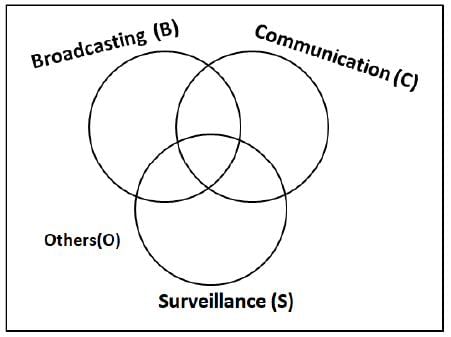
1. The numbers of satellites serving B, C, and S (though may be not exclusively) are in the ratio 2:1:1. 2. The number of satellites serving all three of B, C, and S is 100. 3. The number of satellites exclusively serving C is the same as the number of satellites exclusively serving S. This number is 30% of the number of satellites exclusively serving B. 4. The number of satellites serving O is the same as the number of satellites serving both C and S but not B.
Let '10x' be the number of satellites exclusively serving B. Then, the number of satellites exclusively serving C and S = 0.30*10x = 3x
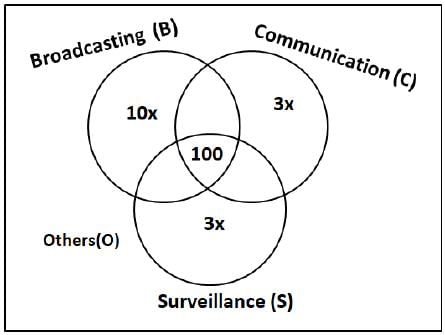
Let 'y' be the number of satellites serving others(O).
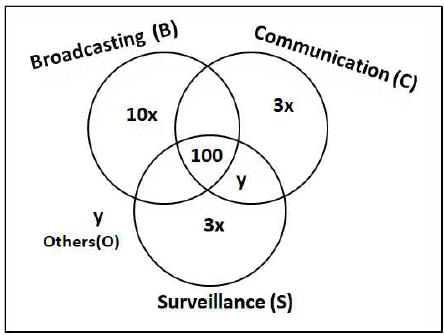
Let 'z' be the number of satellites serving B, C but not S. Since the numbers of satellites serving B, C, and S (though may be not exclusively) are in the ratio 2:1:1. Therefore, we can can say that number of satellites serving B, S but not C = z.

It is given that

The numbers of satellites serving B, C, and S (though may be not exclusively) are in the ratio 2:1:1.
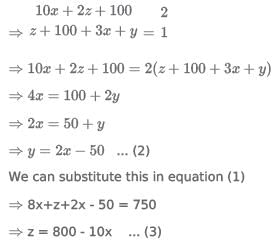

Let us define boundary condition for x,
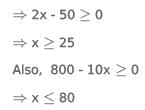
Therefore, we can say that x ∈ [25, 80].
The number of satellites serving B exclusively = 10x. This will be minimum when 'x' is minimum.
At xmin = 25, The number of satellites serving B exclusively = 10*25 =250. Hence, option A is the correct answer.

1. The numbers of satellites serving B, C, and S (though may be not exclusively) are in the ratio 2:1:1. 2. The number of satellites serving all three of B, C, and S is 100. 3. The number of satellites exclusively serving C is the same as the number of satellites exclusively serving S. This number is 30% of the number of satellites exclusively serving B. 4. The number of satellites serving O is the same as the number of satellites serving both C and S but not B.
Let '10x' be the number of satellites exclusively serving B. Then, the number of satellites exclusively serving C and S = 0.30*10x = 3x

Let 'y' be the number of satellites serving others(O).

Let 'z' be the number of satellites serving B, C but not S. Since the numbers of satellites serving B, C, and S (though may be not exclusively) are in the ratio 2:1:1. Therefore, we can can say that number of satellites serving B, S but not C = z.

It is given that

The numbers of satellites serving B, C, and S (though may be not exclusively) are in the ratio 2:1:1.


Let us define boundary condition for x,

Therefore, we can say that x ∈ [25, 80].
The number of satellites serving B exclusively = 10x. This will be minimum when 'x' is minimum.
At xmin = 25, The number of satellites serving B exclusively = 10*25 =250. Hence, option A is the correct answer.
Most Upvoted Answer
1600 satellites were sent up by a country for several purposes. The pu...
Understanding the Problem
We have 1600 satellites that serve four purposes: broadcasting (B), communication (C), surveillance (S), and others (O). The main conditions to consider are:
Setting Up the Ratios
Let’s denote:
- B = 2x
- C = x
- S = x
Since 100 satellites serve all three, we can derive:
From point 3, we know:
Let B exclusive = b. Then:
Finding Values
Solving leads to:
Now, substituting to find relationships and total satellites leads to:
Calculating Minimum B Exclusively
To minimize B exclusively while ensuring all conditions hold:
Thus, the minimum possible number of satellites serving B exclusively is:
Answer: 250
We have 1600 satellites that serve four purposes: broadcasting (B), communication (C), surveillance (S), and others (O). The main conditions to consider are:
- Satellites serving B, C, and S are in the ratio 2:1:1.
- 100 satellites serve all three (B, C, S).
- Exclusive serving numbers: C = S = 30% of B.
- Satellites serving O = Satellites serving C and S but not B.
Setting Up the Ratios
Let’s denote:
- B = 2x
- C = x
- S = x
Since 100 satellites serve all three, we can derive:
- Number of satellites serving B only = (2x - 100)
- Number of satellites serving C only = (x - 100)
- Number of satellites serving S only = (x - 100)
From point 3, we know:
- C exclusive = S exclusive = 0.3 * (B exclusive)
Let B exclusive = b. Then:
- x - 100 = 0.3b
- x - 100 = 0.3(2x - 100)
Finding Values
Solving leads to:
- From the exclusive equations, we derive: b = (x - 100) / 0.3.
Now, substituting to find relationships and total satellites leads to:
- The total from B, C, and S must add up with O to equal 1600.
Calculating Minimum B Exclusively
To minimize B exclusively while ensuring all conditions hold:
- By testing values, we find that if B exclusive = 250, the conditions of ratios and totals hold correctly, fulfilling the requirement for C and S.
Thus, the minimum possible number of satellites serving B exclusively is:
Answer: 250
Attention CAT Students!
To make sure you are not studying endlessly, EduRev has designed CAT study material, with Structured Courses, Videos, & Test Series. Plus get personalized analysis, doubt solving and improvement plans to achieve a great score in CAT.

|
Explore Courses for CAT exam
|

|
Similar CAT Doubts
1600 satellites were sent up by a country for several purposes. The purposes are classified as broadcasting (B), communication (C), surveillance (S), and others (O). A satellite can serve multiple purposes; however a satellite serving either B, or C, or S does not serve O. The following facts are known about the satellites:1. The numbers of satellites serving B, C, and S (though may be not exclusively) are in the ratio 2:1:1.2. The number of satellites serving all three of B, C, and S is 100.3. The number of satellites exclusively serving C is the same as the number of satellites exclusively serving S. This number is 30% of the number of satellites exclusively serving B.4. The number of satellites serving O is the same as the number of satellites serving both C and S but not B.Q.What is the minimum possible number of satellites serving B exclusively?a)250b)100c)500d)200Correct answer is option 'A'. Can you explain this answer?
Question Description
1600 satellites were sent up by a country for several purposes. The purposes are classified as broadcasting (B), communication (C), surveillance (S), and others (O). A satellite can serve multiple purposes; however a satellite serving either B, or C, or S does not serve O. The following facts are known about the satellites:1. The numbers of satellites serving B, C, and S (though may be not exclusively) are in the ratio 2:1:1.2. The number of satellites serving all three of B, C, and S is 100.3. The number of satellites exclusively serving C is the same as the number of satellites exclusively serving S. This number is 30% of the number of satellites exclusively serving B.4. The number of satellites serving O is the same as the number of satellites serving both C and S but not B.Q.What is the minimum possible number of satellites serving B exclusively?a)250b)100c)500d)200Correct answer is option 'A'. Can you explain this answer? for CAT 2024 is part of CAT preparation. The Question and answers have been prepared according to the CAT exam syllabus. Information about 1600 satellites were sent up by a country for several purposes. The purposes are classified as broadcasting (B), communication (C), surveillance (S), and others (O). A satellite can serve multiple purposes; however a satellite serving either B, or C, or S does not serve O. The following facts are known about the satellites:1. The numbers of satellites serving B, C, and S (though may be not exclusively) are in the ratio 2:1:1.2. The number of satellites serving all three of B, C, and S is 100.3. The number of satellites exclusively serving C is the same as the number of satellites exclusively serving S. This number is 30% of the number of satellites exclusively serving B.4. The number of satellites serving O is the same as the number of satellites serving both C and S but not B.Q.What is the minimum possible number of satellites serving B exclusively?a)250b)100c)500d)200Correct answer is option 'A'. Can you explain this answer? covers all topics & solutions for CAT 2024 Exam. Find important definitions, questions, meanings, examples, exercises and tests below for 1600 satellites were sent up by a country for several purposes. The purposes are classified as broadcasting (B), communication (C), surveillance (S), and others (O). A satellite can serve multiple purposes; however a satellite serving either B, or C, or S does not serve O. The following facts are known about the satellites:1. The numbers of satellites serving B, C, and S (though may be not exclusively) are in the ratio 2:1:1.2. The number of satellites serving all three of B, C, and S is 100.3. The number of satellites exclusively serving C is the same as the number of satellites exclusively serving S. This number is 30% of the number of satellites exclusively serving B.4. The number of satellites serving O is the same as the number of satellites serving both C and S but not B.Q.What is the minimum possible number of satellites serving B exclusively?a)250b)100c)500d)200Correct answer is option 'A'. Can you explain this answer?.
1600 satellites were sent up by a country for several purposes. The purposes are classified as broadcasting (B), communication (C), surveillance (S), and others (O). A satellite can serve multiple purposes; however a satellite serving either B, or C, or S does not serve O. The following facts are known about the satellites:1. The numbers of satellites serving B, C, and S (though may be not exclusively) are in the ratio 2:1:1.2. The number of satellites serving all three of B, C, and S is 100.3. The number of satellites exclusively serving C is the same as the number of satellites exclusively serving S. This number is 30% of the number of satellites exclusively serving B.4. The number of satellites serving O is the same as the number of satellites serving both C and S but not B.Q.What is the minimum possible number of satellites serving B exclusively?a)250b)100c)500d)200Correct answer is option 'A'. Can you explain this answer? for CAT 2024 is part of CAT preparation. The Question and answers have been prepared according to the CAT exam syllabus. Information about 1600 satellites were sent up by a country for several purposes. The purposes are classified as broadcasting (B), communication (C), surveillance (S), and others (O). A satellite can serve multiple purposes; however a satellite serving either B, or C, or S does not serve O. The following facts are known about the satellites:1. The numbers of satellites serving B, C, and S (though may be not exclusively) are in the ratio 2:1:1.2. The number of satellites serving all three of B, C, and S is 100.3. The number of satellites exclusively serving C is the same as the number of satellites exclusively serving S. This number is 30% of the number of satellites exclusively serving B.4. The number of satellites serving O is the same as the number of satellites serving both C and S but not B.Q.What is the minimum possible number of satellites serving B exclusively?a)250b)100c)500d)200Correct answer is option 'A'. Can you explain this answer? covers all topics & solutions for CAT 2024 Exam. Find important definitions, questions, meanings, examples, exercises and tests below for 1600 satellites were sent up by a country for several purposes. The purposes are classified as broadcasting (B), communication (C), surveillance (S), and others (O). A satellite can serve multiple purposes; however a satellite serving either B, or C, or S does not serve O. The following facts are known about the satellites:1. The numbers of satellites serving B, C, and S (though may be not exclusively) are in the ratio 2:1:1.2. The number of satellites serving all three of B, C, and S is 100.3. The number of satellites exclusively serving C is the same as the number of satellites exclusively serving S. This number is 30% of the number of satellites exclusively serving B.4. The number of satellites serving O is the same as the number of satellites serving both C and S but not B.Q.What is the minimum possible number of satellites serving B exclusively?a)250b)100c)500d)200Correct answer is option 'A'. Can you explain this answer?.
Solutions for 1600 satellites were sent up by a country for several purposes. The purposes are classified as broadcasting (B), communication (C), surveillance (S), and others (O). A satellite can serve multiple purposes; however a satellite serving either B, or C, or S does not serve O. The following facts are known about the satellites:1. The numbers of satellites serving B, C, and S (though may be not exclusively) are in the ratio 2:1:1.2. The number of satellites serving all three of B, C, and S is 100.3. The number of satellites exclusively serving C is the same as the number of satellites exclusively serving S. This number is 30% of the number of satellites exclusively serving B.4. The number of satellites serving O is the same as the number of satellites serving both C and S but not B.Q.What is the minimum possible number of satellites serving B exclusively?a)250b)100c)500d)200Correct answer is option 'A'. Can you explain this answer? in English & in Hindi are available as part of our courses for CAT.
Download more important topics, notes, lectures and mock test series for CAT Exam by signing up for free.
Here you can find the meaning of 1600 satellites were sent up by a country for several purposes. The purposes are classified as broadcasting (B), communication (C), surveillance (S), and others (O). A satellite can serve multiple purposes; however a satellite serving either B, or C, or S does not serve O. The following facts are known about the satellites:1. The numbers of satellites serving B, C, and S (though may be not exclusively) are in the ratio 2:1:1.2. The number of satellites serving all three of B, C, and S is 100.3. The number of satellites exclusively serving C is the same as the number of satellites exclusively serving S. This number is 30% of the number of satellites exclusively serving B.4. The number of satellites serving O is the same as the number of satellites serving both C and S but not B.Q.What is the minimum possible number of satellites serving B exclusively?a)250b)100c)500d)200Correct answer is option 'A'. Can you explain this answer? defined & explained in the simplest way possible. Besides giving the explanation of
1600 satellites were sent up by a country for several purposes. The purposes are classified as broadcasting (B), communication (C), surveillance (S), and others (O). A satellite can serve multiple purposes; however a satellite serving either B, or C, or S does not serve O. The following facts are known about the satellites:1. The numbers of satellites serving B, C, and S (though may be not exclusively) are in the ratio 2:1:1.2. The number of satellites serving all three of B, C, and S is 100.3. The number of satellites exclusively serving C is the same as the number of satellites exclusively serving S. This number is 30% of the number of satellites exclusively serving B.4. The number of satellites serving O is the same as the number of satellites serving both C and S but not B.Q.What is the minimum possible number of satellites serving B exclusively?a)250b)100c)500d)200Correct answer is option 'A'. Can you explain this answer?, a detailed solution for 1600 satellites were sent up by a country for several purposes. The purposes are classified as broadcasting (B), communication (C), surveillance (S), and others (O). A satellite can serve multiple purposes; however a satellite serving either B, or C, or S does not serve O. The following facts are known about the satellites:1. The numbers of satellites serving B, C, and S (though may be not exclusively) are in the ratio 2:1:1.2. The number of satellites serving all three of B, C, and S is 100.3. The number of satellites exclusively serving C is the same as the number of satellites exclusively serving S. This number is 30% of the number of satellites exclusively serving B.4. The number of satellites serving O is the same as the number of satellites serving both C and S but not B.Q.What is the minimum possible number of satellites serving B exclusively?a)250b)100c)500d)200Correct answer is option 'A'. Can you explain this answer? has been provided alongside types of 1600 satellites were sent up by a country for several purposes. The purposes are classified as broadcasting (B), communication (C), surveillance (S), and others (O). A satellite can serve multiple purposes; however a satellite serving either B, or C, or S does not serve O. The following facts are known about the satellites:1. The numbers of satellites serving B, C, and S (though may be not exclusively) are in the ratio 2:1:1.2. The number of satellites serving all three of B, C, and S is 100.3. The number of satellites exclusively serving C is the same as the number of satellites exclusively serving S. This number is 30% of the number of satellites exclusively serving B.4. The number of satellites serving O is the same as the number of satellites serving both C and S but not B.Q.What is the minimum possible number of satellites serving B exclusively?a)250b)100c)500d)200Correct answer is option 'A'. Can you explain this answer? theory, EduRev gives you an
ample number of questions to practice 1600 satellites were sent up by a country for several purposes. The purposes are classified as broadcasting (B), communication (C), surveillance (S), and others (O). A satellite can serve multiple purposes; however a satellite serving either B, or C, or S does not serve O. The following facts are known about the satellites:1. The numbers of satellites serving B, C, and S (though may be not exclusively) are in the ratio 2:1:1.2. The number of satellites serving all three of B, C, and S is 100.3. The number of satellites exclusively serving C is the same as the number of satellites exclusively serving S. This number is 30% of the number of satellites exclusively serving B.4. The number of satellites serving O is the same as the number of satellites serving both C and S but not B.Q.What is the minimum possible number of satellites serving B exclusively?a)250b)100c)500d)200Correct answer is option 'A'. Can you explain this answer? tests, examples and also practice CAT tests.

|
Explore Courses for CAT exam
|

|
Suggested Free Tests
Signup for Free!
Signup to see your scores go up within 7 days! Learn & Practice with 1000+ FREE Notes, Videos & Tests.
























